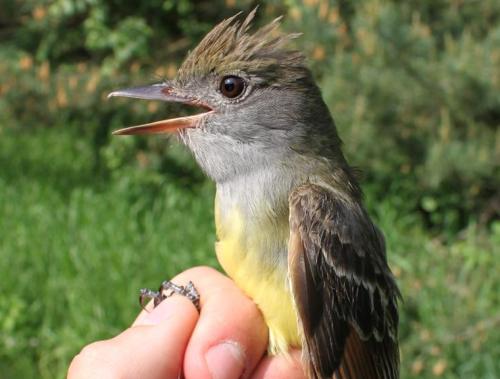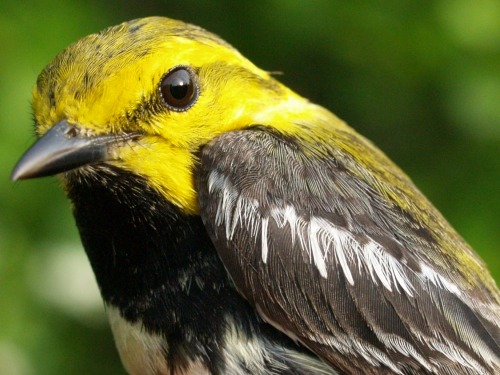|
McGILL BIRD OBSERVATORY |
|||||||||||||||||||||||||||||||||||||||||||||||||||||||||||||||||||||
Welcome
to the McGill Bird Observatory weekly report.
Click here for a complete listing of our archives.
Banders-in-charge: Simon Duval, Gay Gruner Notes: As usual, spring migration came to an abrupt end in week 10, but we still had some late stragglers moving through MBO in this final week of our seventh Spring Migration Monitoring Program. Our tradition is to stop banding on June 1, which tends to be around when the latest migrants take off. This year's results seemed to support that notion, with a full morning of banding on the final day yielding just six individuals. More noticeably, diversity was still high over the final two days of May, with 59 species recorded each day, but then dropped to 48 the next morning, and tapered off to between 34 and 44 for the remainder of the week. For the first time in our seven years of the Spring Migration Monitoring Program, we did not band any new species in the final week of the season, and had only one more addition to our list of species observed this spring, an Eastern Towhee on June 2 (just the fifth ever record for MBO). Our total of 136 species observed is just above the second-lowest spring count of 135 from 2007, though it is worth noting that aside from the unusually high counts of 146 in 2009 and 148 in 2006, the total has consistently been between 134 and 139. The 62 species banded this spring is right on our six-year average, but the 900 individuals banded is a new record, eclipsing the 2008 total of 828 by nearly 10%. Just over one quarter of the species banded this spring (i.e. 16 of 62) were in record numbers for the season. Most noteworthy was Yellow-rumped Warbler, our most abundant species this season with a total of 102 banded, more than double the previous spring record of 47 set in 2008. Two other warblers doubled their previous high, Canada Warbler with 10 (compared to 5 in 2007) and American Redstart (13, vs. 6 in each of 2005, 2008, and 2009), as did Yellow-bellied Flycatcher (5, vs. 2 in 2006) and American Tree Sparrow (15, vs. 7 in 2006). Other species with more modest increases over previous record counts were Black-billed Cuckoo (1 vs. 0), Hairy Woodpecker (4 vs. 3), Yellow-shafted Flicker (3 vs. 2), Traill's Flycatcher (19 vs. 15), Eastern Kingbird (3 vs. 2), Red-eyed Vireo (5 vs. 3), House Wren (5 vs. 4), American Robin (29 vs. 18), Northern Waterthrush (28 vs. 26), Common Yellowthroat (30 vs. 28), and Lincoln's Sparrow (10 vs. 9). Conversely, despite the overall good results this season there were also five species with fewer individuals banded than in any previous spring. We banded only 4 Tree Swallows (previous low 8; average 13), 1 Rose-breasted Grosbeak (previous low 2; average 7), 6 Song Sparrows (previous low 14; average 20), 7 Baltimore Orioles (previous low 11; average 15), and 17 American Goldfinches (previous low 32; average 55).
With only 36 birds banded this week, the top ten list is a bit thinner than it has been in recent weeks, and we omitted the eight species tied for tenth place with one individual each. Cedar Waxwing edged upward to take top spot, which makes the fifth time in the seven years of spring migration monitoring that it has been number one in the final week of the season. In the other two years, Blackpoll Warbler was number one, and this year it came in as the runner-up, for a second week in a row. The three Northern Waterthrushes this week were enough to set a new spring record with a total of 28 banded this season. On the contrary, this week's three Common Grackles were barely enough to tie the existing record low of 11 for a spring season, set in 2008. The remaining species on the list were a mix of presumed local birds (Gray Catbird, Yellow Warbler, Red-winged Blackbird), and late migrants (Traill's Flycatcher, Wilson's Warbler). On the list of species observed, we have a surprise with Canada Goose landing back on top after not even making the top ten last week. This was largely due to several flocks of 30-50 geese flying overhead, a phenomenon noted by a variety of observers across southern Quebec this week; the presumption is that they were already heading to molting areas. The resurgence in goose numbers bumped Red-winged Blackbird and Cedar Waxwing down one spot each from last week, while Ring-billed Gull remained in fourth place and American Crow moved back up to fifth. Interestingly, this is the same top five as in week 7 this spring, except for Cedar Waxwing replacing Yellow-rumped Warbler. The rest of the top ten reflects a fairly typical mix of summer species at MBO. With another spring program successfully completed, we now shift our focus to the birds breeding at MBO. For a third year, we will be keeping track of them through the MAPS (Monitoring Avian Productivity and Survivorship) program, which will involve seven full-morning visits over the course of June and July. We will post a summary report of that brief season in early August, just as fall migration begins again.
|


